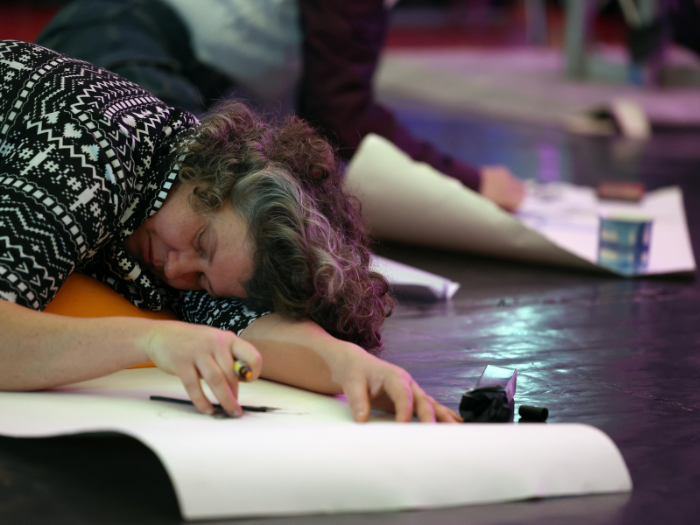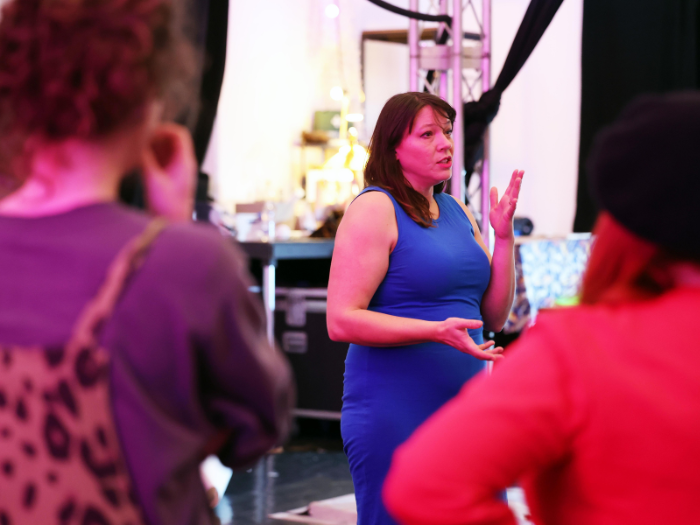
Bridie Doyle-Roberts, a multidisciplinary artist with a background in performance, hosted an event as part of the Creative Industries Cluster Hubs RCT programme. It gave her the chance to explore an idea she’d had for a while: the concept of an ‘art rave’.
“I came up with the idea of an art rave after noticing a number of gaps in the current event options for creatives and artists,” says Bridie. “An art rave is essentially an immersive experience that combines the concepts of a gallery, a theatre performance and a night out. The audience members wander around while lots of people make art, sometimes getting involved and at other times simply observing.”

The definition of an art rave isn’t yet set in stone, but by holding her exploratory event with CICH RCT, Bridie could seek feedback from a dozen fellow creatives of differing backgrounds and test out how different elements of how an art rave might work. She also wanted to look at whether an art rave could tackle some issues within the creative industry.
“Being a creative or an artist can be quite lonely and repetitive,” says Bridie. “The session I held gathered different artists in the room to explore ideas and see whether they felt something like my art rave idea would benefit them. I wanted to encourage artists who work on their own or in one specific way to explore whether there are new ways they can work, new platforms for their work or new collaborations they could try. For example, can a painter perform what they do for an audience? Or can they collaborate with a dancer or musician to elevate what they do into a multidisciplinary piece?
“My background is in theatre, outdoor arts, dance and circus, but I also do other art practices like upholstery and poetry. I was looking at my skill set and thinking about finding ways to support other artists as well as finding new platforms for my own work. The art rave is all about collaboration, supporting each other and finding ways to make our practices somewhat participatory and ultimately entertaining.”

At the event, discussions covered a whole host of areas. “I wanted to consider things like access issues. I'm visually impaired, and another artist in the room was deaf, so we had some good chats around access and the potential things we might need to accommodate in an art rave environment.
“We considered audience expectations and had a go of interactive participation through a physical creative workshop. I led some different physical exercises that I've used in the past - theatrical exercises that are good for improvising with, poetry performance exercises, things with laser projections, music, drawing materials and so on.
“We also tried to come up with ways to enable collaboration across seemingly unrelated practices. For example, how could we have someone throwing a piece of pottery beside a photographer doing a shoot, a performing dancer and someone upholstering a chair? Could they interact with each other in any way? Could they actually share the same space? That was a fun discussion!
“As well as being a research conversation, in a way, the event was an opportunity to gather people together in a room, get to know each other a bit and just enjoy being in the room exploring creatively together.”
The feedback Bridie received post-event was extremely positive:
People said things like, ‘that was brilliant’, ‘we need more things like this’ and ‘this is one of the best R&D sessions I've been to’. I was really pleased.

Since the event, Bridie has considered possible next steps for her art rave:
“I had a chat with Arts Council of Wales about the idea and potential grants to develop it further, and I’ve applied for an upcoming experimental arts festival to see if they’d be interested in an art rave event.
“I feel excited about it. An accessible art rave has the scope to be lots of different things depending on who the artists are. It has a lot of freedom to be something different wherever you take it, and that means it's going to be different every time for the audience as well, which is unusual for semi-performative work. And, it would create more possibilities for people in the creative industries to get involved in collaborative work, try different practices and have fun.
It’s been good to see so many events and activities going on locally through CICH RCT. Yes, the county is spread out and there are issues with things like transport and access, but it would be so good if we were able to put on more interesting things, different things that will draw people out from Cardiff as well as gathering local people together.
"I think it would inspire and encourage people to be creative, to work in the creatives industries and to do so locally (as opposed to having to move away to pursue employment in the creative industries)."
Find out more about Bridie and her work by watching this video:

